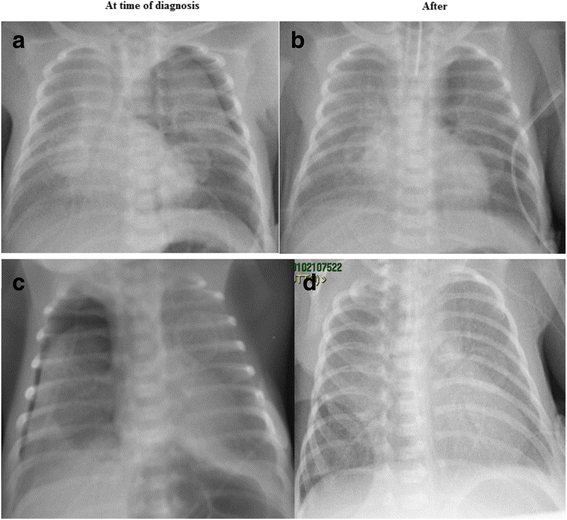Management of pneumothorax in hemodynamically stable preterm infants using high frequency oscillatory ventilation: report of five cases
- PMID: 29273075
- PMCID: PMC5741882
- DOI: 10.1186/s13052-017-0436-y
Management of pneumothorax in hemodynamically stable preterm infants using high frequency oscillatory ventilation: report of five cases
Abstract
Background: Despite an increased use of non-invasive ventilatory strategies and gentle ventilation, pneumothorax remains a common complication in preterm infants. The ventilator management of infants with air leaks remains challenging in terms of both prevention and treatment. Recently the safety and efficacy of expectant management avoiding chest tube drainage to treat large air leak in preterm infants hemodynamically stable has been reported.
Case presentation: In the present study, we report five cases of preterm infants with birth weight ≤ 1250 g affected by respiratory distress syndrome and treated with nasal continuous positive airway pressure as first intention. They were intubated for worsening of respiratory distress with increasing oxygen requirement and concomitant increase of respiratory rate and PCO2 values due to occurrence of pneumothorax, and they were successfully treated using high-frequency oscillatory ventilation without chest tube insertion.
Conclusion: In our experience high-frequency oscillatory ventilation provided a conservative management of a significant pneumothorax in preterm newborns hemodynamically stable and requiring mechanical ventilation. This approach allowed us to avoid the increasing of air leak and the insertion of chest tube drainage and all the subsequent associated risks.
Keywords: Chest drainage; HFOV; Pneumothorax; Preterm infants.
Conflict of interest statement
Ethics approval and consent to participate
The study was approved by the Ethics Committee of the Policlinico Universitario A. Gemelli-Università Cattolica del S. Cuore, Rome.
Consent for publication
Written informed consent was obtained from the parents of the patients for publication of this cases report and any accompanying images. A copy of the written consent is available for review by the Editor of this journal.
Competing interests
The authors declare that they have no competing interests.
Publisher’s Note
Springer Nature remains neutral with regard to jurisdictional claims in published maps and institutional affiliations.
Figures
Similar articles
-
Expectant management of pneumothorax in preterm infants receiving assisted ventilation: report of 4 cases and review of the literature.Respir Care. 2012 May;57(5):789-93. doi: 10.4187/respcare.01446. Epub 2011 Dec 6. Respir Care. 2012. PMID: 22152128 Review.
-
First intention high-frequency oscillatory and conventional mechanical ventilation in premature infants without antenatal glucocorticoid prophylaxis.Pediatr Crit Care Med. 2012 Jan;13(1):72-9. doi: 10.1097/PCC.0b013e318219673e. Pediatr Crit Care Med. 2012. PMID: 21499177 Clinical Trial.
-
High-frequency oscillatory ventilation versus synchronized intermittent mandatory ventilation plus pressure support in preterm infants with severe respiratory distress syndrome.Respir Care. 2014 Feb;59(2):159-69. doi: 10.4187/respcare.02382. Epub 2013 Jun 13. Respir Care. 2014. PMID: 23764865 Clinical Trial.
-
Randomized study of high-frequency oscillatory ventilation in infants with severe respiratory distress syndrome. HiFO Study Group.J Pediatr. 1993 Apr;122(4):609-19. doi: 10.1016/s0022-3476(05)83548-6. J Pediatr. 1993. PMID: 8463913 Clinical Trial.
-
Elective high-frequency oscillatory ventilation versus conventional ventilation for acute pulmonary dysfunction in preterm infants.Neonatology. 2013;103(1):7-8; discussion 8-9. doi: 10.1159/000338553. Epub 2012 Aug 30. Neonatology. 2013. PMID: 23037971 Review.
Cited by
-
Neonatal pneumothorax from the perspective of a pediatric surgeon: classification and management protocol: a preliminary algorithm.Turk J Med Sci. 2021 Jun 28;51(3):1201-1210. doi: 10.3906/sag-2010-286. Turk J Med Sci. 2021. PMID: 33433972 Free PMC article.
-
Pneumothorax in a Preterm Neonate: A Case Report.JNMA J Nepal Med Assoc. 2021 Jul 1;59(238):608-610. doi: 10.31729/jnma.5819. JNMA J Nepal Med Assoc. 2021. PMID: 34508413 Free PMC article.
-
Pneumothorax in a term newborn.J Perinatol. 2024 Apr;44(4):465-471. doi: 10.1038/s41372-024-01899-2. Epub 2024 Feb 26. J Perinatol. 2024. PMID: 38409329 Review.
-
Risk Factors and Outcomes Associated with Pneumothorax in Very Preterm Infants.Children (Basel). 2024 Sep 27;11(10):1179. doi: 10.3390/children11101179. Children (Basel). 2024. PMID: 39457144 Free PMC article.
-
High-frequency oscillatory ventilation: A narrative review.Can J Respir Ther. 2019 May 2;55:40-46. doi: 10.29390/cjrt-2019-004. eCollection 2019. Can J Respir Ther. 2019. PMID: 31297448 Free PMC article. Review.
References
-
- Migliori C, Campana A, Cattarelli D, Pontiggia F, Chirico G. Pneumothorax during nasal-CPAP: a predictable complication? Pediatr Med Chir. 2003;25:345–348. - PubMed
-
- Kitsommart R, Martins B, Bottino MN, Sant’Anna GM. Expectant management of pneumothorax in preterm infants receiving assisted ventilation: report of 4 cases and review of the literature. Respir Care. 2012;57:789–793. - PubMed
MeSH terms
LinkOut - more resources
Full Text Sources
Other Literature Sources
Medical


